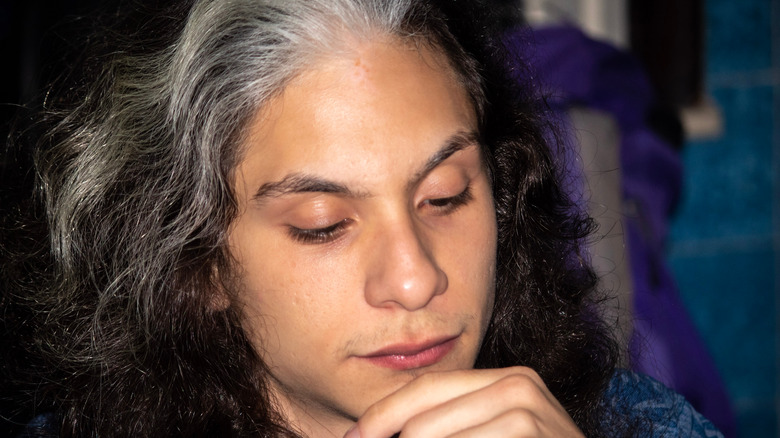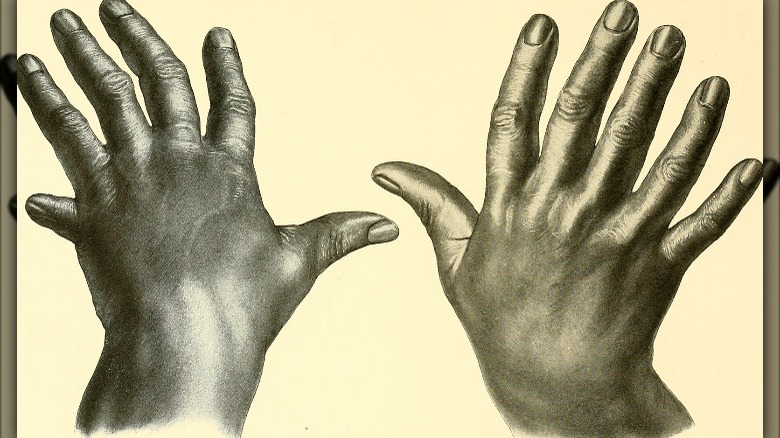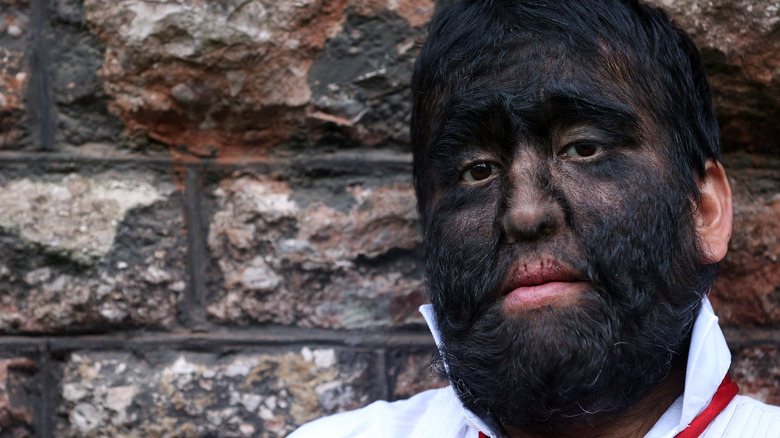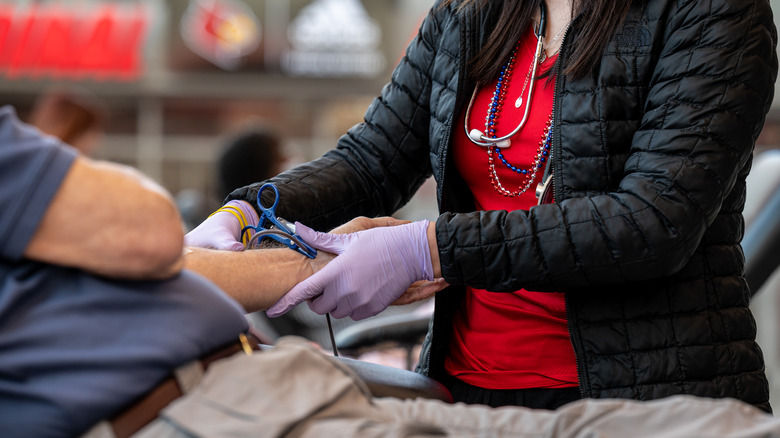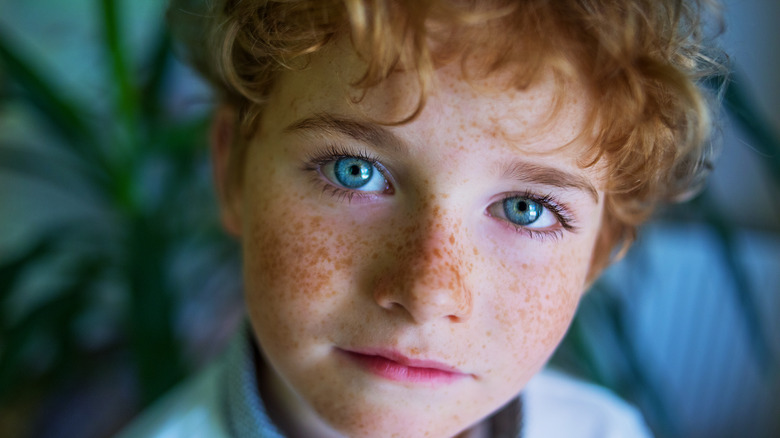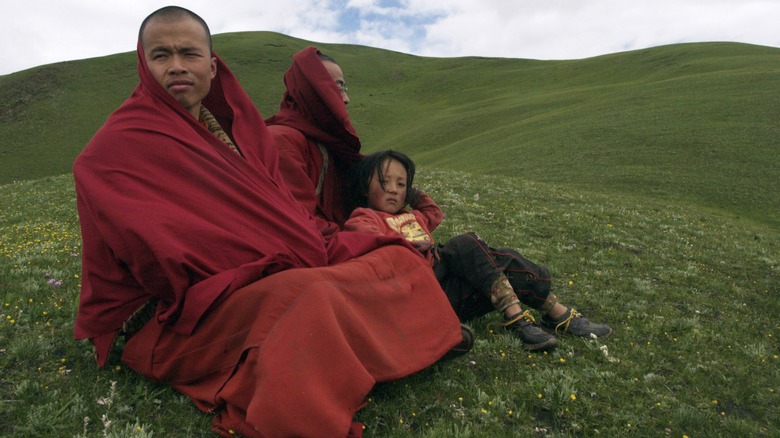The Rarest Body Features Human Beings Can Have
It's no secret that there are a lot of people sharing this big, blue marble floating through space. Specifically, Population Reference Bureau says there are about 7.8 billion people that make up the world's population. The organization also says that over the course of the existence of Homo sapiens, there have been around 117 billion of us born. Which brings up an important question: What makes us so special? And is there anyone out there just like us?
Some say yes and point to instances where people have come face-to-face with, well, their own face. While the BBC says there's a 1 in 135 chance that any given person will have a completely identical look-alike out there somewhere, things get a little weirder when measurements are a little less mathematical than they were in the study that came up with that number. Notably, face perception researcher Winrich Freiwald told the publication that "it's comparatively easy to find good matches."
But how does that work if we're talking about someone who hit the genetic lottery and scored a super-rare physical feature? There are more of those out there than you might expect, and it's an odd thing. While some of these rare features are shared among a percentage of the population, others are truly one-of-a-kind.
A right-sided heart
When someone's asked to swear an oath with a hand over heart, the general idea is to put the right hand over the left side of the chest. For 99% of people, that's absolutely fine — that's the way the heart is pointing. But the other 1% of people can get away with not keeping their word because of a technicality. It's called dextrocardia, and Healthline says that while no one's really sure what causes it, experts have found that it happens early on in pregnancy and the development of the baby.
People with dextrocardia can live perfectly ordinary lives or, on occasion, can suffer some side effects like breathing difficulties and a compromised immune system. In some cases, it can impact the function of the heart and other organs, cause things like jaundice and exhaustion, and may need surgical intervention to correct. Occasionally, dextrocardia exists alongside another super-rare condition called situs inversus. That's when it's not just the heart that's on the "wrong" side of the body, but all of the organs are flipped in a sort of mirror image of what they typically are.
Fingers and toes without nails
Fingernails and toenails are the sort of thing that most of us take for granted, but there's a rare condition that results in a person lacking some or all of either set of nails. It's called anonychia congenita, and the National Library of Medicine's MedlinePlus says it's not clear just how common a trait this is — just that it's unusual. Research published in the Indian Dermatology Online Journal goes a step further and says that when the lack of nails occurs alone and without any other abnormalities, it's "extremely rare."
So, what's going on here? It comes from a mutation in a gene that controls the manufacturing of a protein called R-spondin-4, and it's the same gene that plays a role in telling the body's tissues and cells how to develop. It's involved in the development of our arms and legs, and it's extremely important when it comes to the way the fingertips and toes form. Sometimes, mutations in the gene result in no proteins being made, which results in no toenails or fingernails. A person can be a carrier for the gene, but it requires inheriting two copies of the mutated gene for the abnormality to develop, adding to the rarity of the condition.
Piebaldism
The Indian Dermatology Online Journal describes piebaldism as "a rare autosomal dominant disorder of melanocyte development." So what the heck does that mean?
It simply means that a person has patches of skin and/or hair that have no melanin, which is what gives both of those things their color. The result of this lack of melanin is that these patches of skin or hair are lighter than other areas, often presenting as white. According to the National Library of Medicine's MedlinePlus, about 90% of people who have piebaldism have a white streak of hair in the front. It's also common to see white eyebrows and eyelashes, along with unpigmented patches of skin on other parts of the body.
There's another condition that causes a similar non-pigmentation of skin, and that's vitiligo. Vitiligo, however, develops later in life, while piebaldism is present at birth and is thought to be the result of mutations in the genes that control the development of the cells that produce melanin. Given that only one copy of the mutated gene can cause the pigmentation, it's often passed down through the generations — but it's not linked to impacts on a person's health.
A genetic marker that regulates cholesterol
Americans hear a lot about cholesterol, and it's no wonder: The Centers for Disease Control and Prevention estimates that about 38% of adults have high cholesterol, which comes with an increased risk of things like stroke and heart disease. But two women — one from Texas and one from Zimbabwe — don't have to worry about their cholesterol at all, thanks to a gene mutation that keeps their cholesterol low.
According to The New York Times, the two women are the only known people with the super-rare condition that requires inheriting two copies of the mutated gene, one from each parent. The Texas woman was discovered by researchers from the University of Texas Southwestern Medical Center as they were looking for people who had mutations to the gene that was linked to high cholesterol. The idea was that if a gene could slow the body's ability to process cholesterol, different mutations should increase that ability — and they did. Meanwhile, a similar line of research was being followed in South Africa, and scientists there came to the same conclusion.
Although this mutation is super rare, it kicked off major research into cholesterol-lowering medications and has the potential to impact millions of lives.
Uncombable hair
In 2022, The Independent reported the story of Katelyn Samples, a woman from Georgia who had been sharing pictures of her son on social media. It was in July of 2021 that a stranger reached out to let her know that his wild, white-blond hair was actually indicative of a rare condition called uncombable hair syndrome.
It's also called "spun glass hair," and that pretty much sums it up. The condition develops in children between 3 months and 12 years old and causes frizzy and dry hair that can't be combed flat, grows out from the scalp in all directions, and is usually either bright blond or silver. According to the National Library of Medicine's MedlinePlus, it's caused by a mutation in the genes that controls how the hair grows. While most people have hair that's cylindrical, those with uncombable hair actually have strands of hair that are triangular, heart-shaped, or even flat.
Samples' son, Locklan, is a very rare individual, indeed — there are only 100 confirmed cases of the condition, which sometimes becomes less noticeable with age.
A sixth finger
Polydactyly — having extra fingers and toes — isn't terribly uncommon. Estimates on the prevalence of the condition vary: Imperial College London suggests that it happens in as many as 1 in 500 births, while Healthline estimates that the number is around 1 in 1,000.
There are different types of polydactyly, and here's where things start getting into the "rare" territory. Regardless of what finger is extra, the majority of polydactyl people have surgery as children to remove the extra fingers or toes. That can range from a simple procedure to a complete rebuilding of the structure of the hand, but some people keep their extra digits — and they can be a major advantage.
In 2019, joint research from universities in Germany, London, and Switzerland published some fascinating findings. They did a series of studies on two polydactyl individuals — a 17-year-old man and his 52-year-old mother — to see how they performed everyday tasks and how their brains adjusted for the extra digit. As they were asked to do things like play video games, an MRI machine mapped their brain activity.
The researchers found some wild stuff. Not only could they do some things — like tying shoes — with one hand, but they also found that their brains had naturally adjusted to the extra effort of controlling an extra digit. The resulting benefits are hoped to be twofold because in addition to showing that an extra finger isn't a defect but a bonus, researchers hope to learn something about controlling robotic limbs, as well.
A spleen for deep-sea diving
No one's going to know if someone has an extra-large spleen at a glance, and though it's an organ that's not technically needed for our day-to-day life, having one means that your immune system has an extra boost. Notably, National Geographic says that it helps the body recycle those red blood cells. The publication also says that one group of people — the Bajau, who live on houses and houseboats in the waters of Indonesia, the Philippines, and Malaysia — have developed extra-large spleens that allow them to do some incredible things.
According to Healthline, the average person is capable of holding their breath for between 30 seconds and 2 minutes. But the Bajau peoples' rare spleens give them the ability to hold their breath for up to 13 minutes while diving up to 200 feet beneath the waters they call home. Research published in Cell determined that the Bajau have a spleen that's about 50% larger than the spleens of most people — and that included people living on the Indonesian mainland. It's believed that this relatively small group of people have developed this incredible feature due to a mutation in their DNA, and the presence of the gene PDE10A. Scientists from the Center for Geogenetics at the University of Copenhagen suggest that this rare spleen size only happened after thousands of years of natural selection.
A ton of hair, everywhere
Hypertrichosis is the name of a rare condition that results in excessive hair growth over a person's entire body (via DermNet NZ). Strangely, although it's considered a genetic disorder, it's not always present at birth — some of the 50-odd individuals diagnosed with the condition only developed it later in life in what researchers call a "spontaneous mutation." According to Medical News Today, these can be caused by things like malnutrition and autoimmune diseases. (It's also worth noting that this isn't the same as hirsutism, which is a condition that causes women to grow hair in typically masculine areas, like the face, chest, and back.)
There are several different types of hair that might start to grow, and researchers have actually traced the condition to extra genes on the X chromosome that essentially overload the body's genetic instructions for hair growth (via Live Science). Individuals with hypertrichosis have, throughout history, been exhibited in traveling freakshows: The Human Marvels tells of people like Alice Doherty, who was known as the Minnesota Woolly Girl. When she was born in 1887, she became the only American to ever have the condition. There were others, too — Percilla the Monkey Girl was born in 1911 and like Doherty, she was also exploited by her father. There's also the story of Barbara the Hairy Maid, who was put on display in the mid-17th century (at least one professional who examined her claimed she was the daughter of an ape and a woman).
Certain blood types
According to the NHS, there are 36 different blood groups and eight "main blood types." The latter consists of the familiar-sounding ones like O, A, B, and AB (positives and negatives), but let's talk rare. Among this group, the rarest is AB negative — just 1% of the population has this type of blood, though that's actually pretty widespread compared to some of the other types.
The NHS says that of their 830,860 donors, Sue Olds from Cornwall is the only one with a -D- blood type. There's also a single person with KL- and one with Hy-, but the NHS claims it's the -D- that's super valuable, as it can be given to a wide range of recipients with no side effects. There's also what MedicineNet calls the "golden blood type." It's more scientifically called the Rh null blood group, and with fewer than 50 people in the world having it — and only nine of those people regularly donating it — it's the rarest blood type of them all.
What makes that blood type difference is that there are no Rh proteins on the red blood cells, which makes them a universal donor. Though this is great, it comes with a huge problem: Anyone who has Rh null blood can only receive a blood transfusion from another Rh null person, and given how rare they are, it's a physical feature that could very quickly become deadly.
Being a blue-eyed redhead
When it comes to the rarity of hair and eye color combinations, there's one that's the rarest of all: being a blue-eyed redhead. Why?
According to Medical Daily, this particular combination is rare for two reasons. First, each trait is relatively rare by itself: Red hair is found in somewhere between 1% and 2% of the population, while only about 17% have blue eyes. Both traits are also recessive, which means that a person would need to inherit the redheaded genes and the blue-eyed genes from both parents. Reader's Digest did the math and found that although it's variable and the real-world population doesn't always work out to be mathematically sound, about 0.17% of the world's current residents are both red-haired and blue-eyed.
It's so rare that the University of Melbourne actually did a deep dive into the possibility that the color combination was going extinct. Evolutionary biologist Mark Elgar says that it's unlikely, though, as even though the genes don't always manifest because of their recessive nature, they're still being carried and passed along to future generations.
Unbreakable bones
Richard Gunderman, a professor of medicine at Indiana University, says that dense bones aren't unusual (via The Conversation). But dense bones usually become brittle and easily broken in a condition called osteoporosis. Interestingly, research has isolated a few unique families that have bones that are not only dense but are also apparently unbreakable.
The phenomenon came to the attention of the medical community when one man was in a car accident that should have left him little more than a pile of broken bones. When he walked away, though, X-rays showed that not a single bone was fractured. Further investigation revealed that his bone density was about eight times that of a normal person, and still further study led researchers from Yale to the realization that it was a trait that had passed down through the family. Those who had the rare feature were obvious at a glance, as they also had very square-jawed faces.
Members of the family reported side effects: They were incredibly bad swimmers because they would sink, and hip replacement surgeries failed because doctors couldn't penetrate through bones. Strangely, Science says that there's another family with incredibly strong bones, but theirs come coupled with curly hair and brittle, incredibly fragile teeth. It's called tricho-dento-osseous syndrome, is present in just a few thousand people, and was traced back to one person: a Scottish sea captain who emigrated to the U.S. when it was still a British territory.
A genetic immunity to sleep deprivation
Is there a physical feature that allows people to get by on just a few hours of sleep every night? Yes, says Scientific American, and it's a genetic mutation on a gene named DEC2.
This mutation was studied in 2009 when researchers from the University of California, San Francisco, looked at a mother and daughter who both had the mutation and who felt well-rested and absolutely fine with just about six hours of sleep a night. With most people needing between seven and eight hours, that six hours a night usually comes with ill effects felt after just a few days. With the genetic mutation, though, they were fine.
Sorry to burst the bubble of everyone who would absolutely love to be able to do this, but it's estimated that only about 1% of the population has this mutated gene. And here's the thing: According to the National Institutes of Health, there's likely much more to this full yet substantially shortened sleep cycle. Is it likely that further research will find more physical traits that allow these people to get by on so little sleep? Probably — as Dr. Louis Ptacek told the agency, "Sleep is complicated."
Genetic adaptations to high-altitude living
In 2004, National Geographic reported on a series of studies that looked at groups of people living in high-altitude environments where the oxygen is much thinner than what the majority of people are used to. They found that each group had developed rare biological traits in order to help them not just survive in these conditions but also thrive.
People living in the Andes Mountains of South America have developed red blood cells with the ability to carry much more oxygen per cell than most people, and that makes their entire circulatory system much more efficient. Meanwhile, those living in Tibet have adapted in a different way: Not only do they take more breaths to bring more oxygen into their bodies, but they've evolved expanded blood vessels and the ability to basically make up for a lack of oxygen by increasing the blood flow through their systems.
Just how the residents of the Ethiopian highlands had adapted to living at high altitudes remained a mystery a little longer, but in 2012, research published by the University of Pennsylvania revealed that study participants in this test group had a different biological feature: a mutation in the gene that controlled the cells' ability to make energy. The team behind the study suggests that these unique physical features evolved over tens of thousands of years as people gradually became capable of living at higher and higher altitudes.



